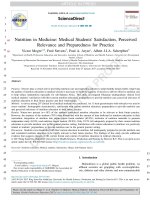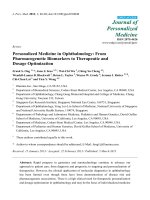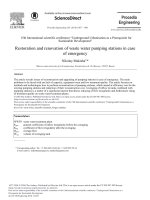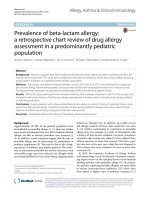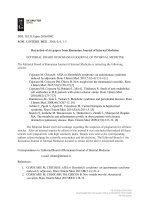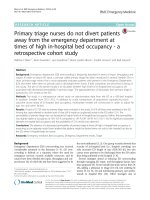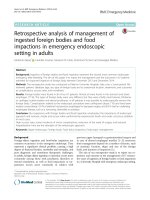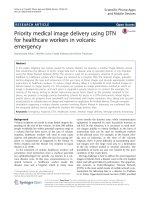Pediatric emergency medicine trisk 620
Bạn đang xem bản rút gọn của tài liệu. Xem và tải ngay bản đầy đủ của tài liệu tại đây (236.66 KB, 4 trang )
FIGURE 96.4 Milia. (Reprinted with permission from Jensen S. Nursing Health Assessment .
Philadelphia, PA: Lippincott Williams & Wilkins; 2010.)
FIGURE 96.5 Erythema toxicum. (Reprinted with permission from Fletcher M. Physical
Diagnosis in Neonatology . Philadelphia, PA: Lippincott-Raven Publishers; 1998.)
FIGURE 96.6 Neonatal acne. (Courtesy of Amy Ross, MD. In: Chung EK, Atkinson-McEvoy
LR, Boom JA, et al., eds. Visual diagnosis and Treatment in Pediatrics . 2nd ed. Philadelphia,
PA: Lippincott Williams & Wilkins; 2010. With permission.)
Significant Neonatal Rashes (See Chapter 69 Rash: Neonatal
)
HSV Infection
HSV is the most important condition to consider when evaluating a vesicular
eruption because of its significant associated morbidity and mortality.
Current Evidence. Most neonatal HSV infections are caused by HSV type 2.
While transplacental transmission can rarely occur, most neonatal HSV disease is
acquired perinatally from infection of the maternal genitourinary tract. Primary
maternal infection at the time of delivery is associated with a 40% to 50% chance
of transmission but most neonates with HSV are born to mothers who did not
provide a history of HSV infection or other identifiable risk factors.
Clinical Considerations. Goals of treatment: early diagnosis and prompt
initiation of antiviral therapy to decrease morbidity and mortality.
Clinical Recognition. The infant can appear well at birth but become ill at days 4
to 7, at which time a vesicular eruption may be noted ( Fig. 96.7 ). The most
common lesions are small vesicles on an erythematous base which may become
pustular in 1 to 2 days. However, early manifestations can be subtle and
nonspecific. HSV should be suspected in infants with or without vesicles who
present with sepsis, respiratory distress, focal neurologic signs, or signs of
hepatitis or liver failure.
FIGURE 96.7 Herpes simplex infection. (Reprinted with permission from Goodheart HP.
Goodheart’s Photoguide of Common Skin Disorders . 2nd ed. Philadelphia, PA: Lippincott
Williams & Wilkins; 2003.)
Triage Consideration. Neonates presenting with new vesicles should be seen
promptly.
Clinical Assessment. Neonatal HSV is categorized into three main categories:
localized skin, eye, and mouth (SEM) disease; central nervous system (CNS) with
or without SEM; and disseminated disease, which may involve CNS, SEM, and
other organs. Comprehensive laboratory evaluation should occur in infants with
suspected HSV, even if only limited SEM involvement is suspected. Obtain CBC,
blood chemistry, liver function tests, urinalysis, blood and urine culture, lumbar
puncture, HSV polymerase chain reaction (PCR) of the blood, cerebrospinal fluid
(CSF) cell count, glucose, protein, HSV PCR, viral culture, surface culture from
conjunctiva, mouth, nasopharynx, and rectum—placed in single viral transport
media tube—and evaluation for bacterial or metabolic disease as indicated.
Management. If a neonate is suspected of having HSV, perform a complete sepsis
workup, start acyclovir, and admit the patient to the hospital. Infants may require
supportive care with intubation, mechanical ventilation, and cardiac support for
disseminated disease. In addition, infants with significant liver dysfunction may
require transfusions in the setting of significant coagulopathy and bleeding.
Neonatal Varicella
Current Evidence. Neonatal varicella may develop when maternal varicella
infection occurs during last 2 to 3 weeks of pregnancy or the first few days
postpartum. The severity of neonatal disease depends on timing of maternal
infection. If maternal disease onset is 5 or more days before delivery, the
infection in the newborn is usually mild because of transplacental passage of
maternal varicella IgG antibodies. If maternal disease is within 4 days before
delivery the neonate is at risk of developing severe infection, with mortality as
high as 30% caused by pulmonary or visceral involvement. Infants born to
mothers who demonstrate chickenpox lesions within 2 to 5 days of delivery
should receive varicella zoster immunoglobulin.
Clinical Recognition. The classic rash is described as vesicles on an
erythematous base, or “dew drops on a rose petal” ( Fig. 96.8 ).
Goals of Treatment. Early recognition, support, and prompt initiation of antiviral
therapy for moderate to severe cases of varicella.
FIGURE 96.8 Varicella infection. (Reprinted with permission from Burkhart C, Morrell D,
Goldsmith LA, et al. VisualDx: Essential Pediatric Dermatology . Philadelphia, PA: Lippincott
Williams & Wilkins; 2009.)
